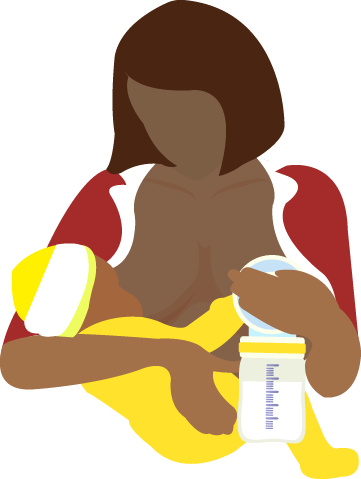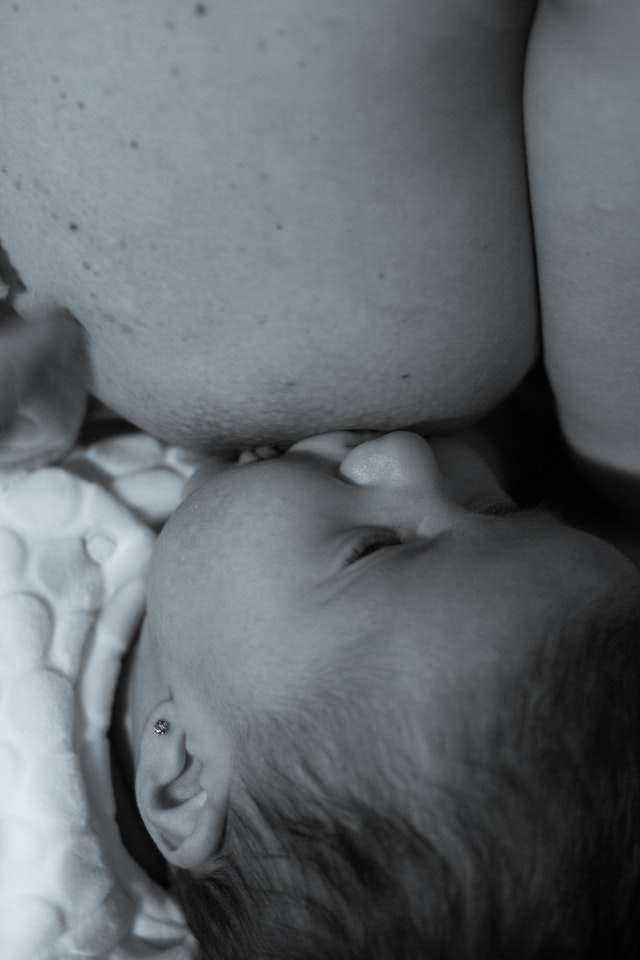For women who have large breasts, breastfeeding may feel like a daunting challenge, but, getting it right is about making sure you and baby can feed with good positioning and attachment…
Get a Good Bra Fitted
Firstly, it is important to have good bra support and to go and get correctly measured for a well-fitting and comfortable maternity bra. You may need to do this about 3 times from pregnancy to after birth, as your breasts will be changing shape along your journey. It’s very important that you do not wear an underwire bra or a bra which is too small and cuts into your skin.
Your breasts start making milk (colostrum) in the cells from around 16 weeks pregnant. Having too much pressure on your delicate breast skin from this point may put you at risk of developing blockages and pain. This is particularly important once your milk comes in after birth as this can also restrict the flow of milk to your baby.
The reason why it is best to go and have a proper bra fitting is that most of us women are actually wearing the wrong bra size to start with! This is not a time to be walking around with an incorrect fit.
Understand the Difference Between Breast Size and Milk Output
All breasts come in a variety of shapes and sizes. We are all different and this is normal. A common myth is that a woman with larger breasts makes more milk than a woman with smaller breasts.
Actually, the truth is that the size of your breast does not dictate how much milk you will be able to make. It’s about how much milk the cells inside your breast can make and this is not based on breast size.
The breasts are made up of glandular tissue (containing the milk-making cells), fatty tissue which often represents the size of our breast, and connective tissue. So we cannot assume a woman with G cup breasts will have more milk than the woman with C cup breasts.
Learn About Feeding Ergonomics
Often we may only see images of 3 ways of breastfeeding, but this is not true at all. Remember the breast and the baby’s mouth are round, so technically any position is possible… that doesn’t mean it’s comfortable though! And comfort is the key here. The key to successful breastfeeding is getting the positioning and attachment right for mum and baby.
No matter what size breasts they have some mums and babies breastfeed from the beginning with no problems at all, while other mums and babies take a little bit more time to get things right.
Feeding with larger breasts is about being comfortable and being able to see what baby is doing when they attach. Both of these can take a little practice, for any mum.
Give Your Breasts the Support they Need
Many mums find that using a pillow in the early days can help position baby at the right height so they can see baby’s mouth clearly. It’s really important to watch out that you don’t lift your baby up on a pillow above the height of your naturally resting nipple.
If you do this then you’ll end up lifting your breast to meet your baby’s mouth and will find as soon as you let go of your breast the weight of the breast will pull the nipple out of baby’s mouth! So the key here is to bring baby to the level of your resting nipple.
Other ways of tilting your nipple upwards so you have a better view of your baby’s mouth next to your nipple is to use a rolled-up cloth nappy/thin bunny rug and placing it under your breast. This can really increase your viewing. You may also like to try breastfeeding in front of the mirror so you can see where baby is attaching, until you feel more confident.
Look for Positions that Work for You
Try lots of different positions. There is no one perfect position for every mother, and most mums use a variety of styles depending on whether they are at home, out and about or lying down.
Laid back feeding styles can be really helpful for every breast shape and size as it allows your baby to use their innate reflexes to find the breast and attach themselves. You can find some helpful information here.
Other positions are the modified cradle hold, where baby sits/lies in your lap and is supported behind their shoulders to attach onto the breast. Some mums like the underarm hold as baby is supported beside you and mums often feel like they have support of their baby’s head and neck as well as a perfect view of baby’s mouth, while others love lying down to feed.
These are all positons you can practice with the help of your midwife in hospital and at home.
Consider Shaping the Breast
Lots of mums find it helpful to shape their breast just before baby attaches on to the nipple and underneath part of the areola. Shaping can help baby get a deeper attachment.
It’s important that baby is not just sucking on the end of the nipple. In order to drain the milk effectively and cause no pain baby needs to have the nipple and some of the areola in his mouth.
Babies do not have to take all of your areola in their mouths! But if you have small areola then he may take it all. There are two ways of holding your breast; it is often called the hamburger technique!
Imagine you are eating a really full, delicious burger (veggie burger for the vegetarians). Think about how you pick it up. You will squeeze it to reduce the size so that you can have a bite of the bun, filling and the burger.
Then you tilt your head back slightly, and bring your bottom lip to the bun first, almost hooking your mouth over the whole burger, so you can fit more in your mouth.
This is what babies do when they come to the breast to feed, tilt their head slightly, and come onto the breast lower lip first with their chin leading.
So shaping the breast can be helpful for some mums and babies to enable baby to get a deeper attachment on the breast.
How do you do it? If you are holding baby in cradle hold then you want to hold your breast in a “U” shape, from underneath your breast. If you are holding baby in an underarm hold you will need to hold your breast in a “C” shape, from the side of your breast.
Wear Clothes That Give You Confidence
Many mums worry that they will be exposing themselves a lot if they have larger breasts. Here are a few tips if you are feeling self-conscious. Practice feeding your baby in the mirror first before you go out.
Try out different tops to find the ones you feel most comfortable feeding in and wear those for your first feeds in public. Try wearing a breastfeeding cami top underneath your t-shirt so you still feel covered whilst feeding.
On your first trip breastfeeding in a café or public place find a secluded chair to feed. Once you find your confidence and breastfeeding style you’ll find breastfeeding out and about to be no problem at all and the easiest method of feeding your baby.
Don’t Be Afraid to Seek Out Advice and Support
Never feel concerned about how much support you need when learning to breastfeed. Nearly every mum finds some aspects of breastfeeding challenging at first and will have good and bad days.
Utilise your local breastfeeding support centres and their lactation consultants and maternal child health nurses until you are feeling confident. There is nothing better than a bit of coaching and TLC from a warm and friendly breastfeeding specialist to help you feel that you can do this!
Source: Medela
Link: https://www.medela.com.au/breastfeeding/blog/breastfeeding-tips/8-tips-for-breastfeeding-with-larger-breasts




